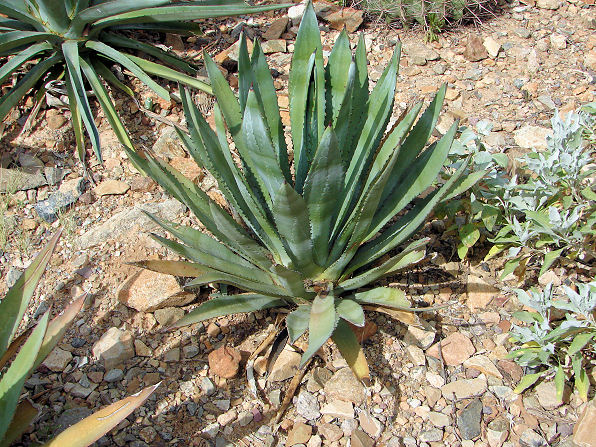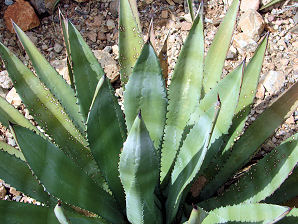Xeriscape Landscape Plants & Flowers
For The Arizona Desert Environment.
Pictures, Photos, Images, Descriptions, & Reviews.
Murphy's Agave, Agave murpheyi.
We Are Proud Of Our SafeSurf Rating!
Click On Any Of The Following Links By Amazon.Com
For Books, & Videos About Wildflowers Of Arizona & The Southwest USA. No Obligation!
 |
| Murphy's Agave, Agave murpheyi. Arizona - Sonora Desert Museum. Near Tucson, Arizona. September 29, 2006. |
|---|
 | |
| Murphy's Agave. Agave murpheyi. | Murphys Agave. Agave murpheyi. |
|---|
 /
/

Murphy's Agave.
We wish to thank Wikipedia, the free encyclopedia for some of the information on this page. We share images and information with Wikipedia. A beautiful, small to medium Agave from Central Arizona and Sonora Mexico which has very wide, heavily cross-banded, blue and purplish leaves. It is highly tolerant of drought conditions and full sun. It has greenish yellow to yellow flowers, with reddish petal margins, on a 14 feet tall panicle in early winter and spring. The plant produces an abundance of bulbils on the flower stem. Tolerates poor soil and drought, but requires excellent drainage. They were cultivated by the ancient Hohokam People in the Phoenix area. The Tohono O�odham people of Arizona, and ranchers of Sonora, Mexico continue to cultivate Murphy's Agave. In the past, Agave murpheyi, also known as the Hohokam agave, was a succulent plant that was found growing only at a few dozen archaeological sites of the ancient Hohokam Indians in southern Arizona and northern Sonora Mexico. Evidence shows that it was grown by the ancient Hohokam People for food and fiber. Further evidence shows that agave fields were cultivated over seventy-eight square kilometers (almost 20,000 acres), mainly between Phoenix and Tucson, indicating that the agave was a major source of food for the Hohokam who numbered in the tens of thousands. Undoubtedly many other fields have been destroyed or are undetected by archaeologists. For food, the basal rosette was harvested just before the Hohokam agave sent up a flower stalk. At this time the concentration of sugars in the rosette is at its highest The rosettes, resembling a pineapple and weighing about nine pounds, were cooked for two or three days in a pit filled with hot stones and covered with hot coals and dirt. The baked rosette, compared in taste to a sweet potato (although containing inedible fiber) is nutritious with 347 calories and 3.5 grams of protein per 100 grams. The fiber extracted from agave is tough and flexible. The Hohokam roasted the fleshy leaves, then defleshed them with stone scrapers to expose the long fibers. They used the fibers for making baskets, rope, textiles, sandals, and brushes.
Quick Notes:
Height: 2 to 4 feet feet tall. It also spreads about 2 to 4 feet.
Flowers: A short stalk emerges from the center of the plant, it becomes 10 to 14 feet tall. Then greenish - yellow flowers with reddish petal margins emerge from the stalk on about 12 side branches. The flower stalk signals the end of the plant's life cycle.
Flowering Time: Phoenix Arizona, Mid February - April.
Leaves: The leaves form a basal rosette, they are 20 to 32 inches long and 2 1/2 to 8 inches wide, ranging in color from light glaucous green to yellowish - green, often with light cross - lined patterns. The leaf margins are undulate with small teeth.
Found: Native Central Arizona and Mexico (Sonora). The USDA claims it is native of the USA (AZ).
Hardiness:
Soil pH requirements:
Sun Exposure:
Elevation: Best from 1,300 to 3,200 feet. In Arizona. Will grow at lower to higher elevations.
Habitat: It grows well in sand, sandy loam, clay and other heavy soils. It needs good drainage and aeration. It is remarkably tolerant of alkali.
Miscellaneous: Maintenance: Low. Photos Taken; Arizona - Sonora Desert Museum, near Tucson, Arizona. September 29, 2006.
|



We Are Proud Of Our SafeSurf Rating!
Click On Any Of The Following Links By Amazon.Com
For Books, & Videos About Xerioscape Plants Of Arizona & The Southwest USA. No Obligation!
Back To Arizona Xeriscape Landscaping Main Page.
Back To Xeriscape Succulents Page Three.
Back To Arizona Wild Flowers Home Page.
Back To Arizona Wild Flowers, Yellow Flowers Page Nine.
Back To DeLange Home Page
© 1966 - Present, Audrey, Eve, & George DeLange
| © 1966 - Present, Audrey, Eve, & George DeLange |


